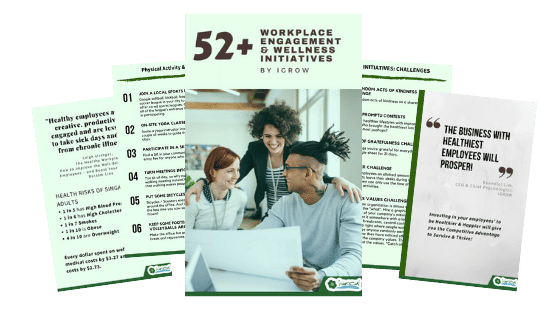Articles
Pride and The Workplace: Demystifying the LGBTQ+ Community
Opening Closet Doors: Welcoming LGBTQ+ People In The Workplace is a short series of informative articles about workplace discrimination against LGBTQIA+ people and what your company can do to be an inclusive and open place for people of different SOGIE backgrounds. ***The LGBTQIA+ community has been gaining a lot of prominence and attention worldwide in recent decades. Not that they haven’t always existed—gay and trans and bisexual people have existed for as long as human communities have—but with the advent of social media giving voices to more marginalized communities, they feel more prominent than ever. Because of the marginalization of LGBTQIA+ identities, many experience mental health challenges such as depression and anxiety, due to the lack of acceptance in society in general. As a way of celebrating Pride Month, we at iGROW would like to discuss the history of this movement and the mental health challenges that they face in society—and what businesses and managers can do to ensure the safety and mental wellness of their LGBTQIA+ employees. Definition of Terms In this part, we will discuss some important key terms that LGBTQIA+ people use to describe themselves and the world. It can feel complicated to learn these terms, and a lot of people claim that they are “unnecessary” because it doesn’t reflect their own personal experiences and beliefs which tend to align with traditional perspectives. But do keep in mind that these terms are not harmful to anyone despite what some people may say, and they help many people whose identities and lives fall outside the traditional perspectives to be able to describe themselves properly and to help understand who they are and thus bolster their self-worth and their place in the world at large. So, yes, allow yourself an open mind, and see that these terms may not be made for you, but they are made for someone, and they have a positive effect on the lives of those people. LGBTQIA+ - a broad term for the coalition of sexual orientations and gender identities/expressions that do not fall under the traditional perspectives of society. The plus sign at the end is to allow for other gender identities and sexual orientations that would fall under the umbrella but aren’t necessarily named in the acronym. The letters are short for ‘Lesbian, Gay, Bisexual/Biromantic, Transgender, Queer/Questioning, Intersex, and Asexual/Aromantic’ SOGIE - short for ‘Sexual Orientation, Gender Identity and Expression,’ is a neutral catch-all term to describe a person’s gender and sexual leanings. It is something that everyone has, and this terminology is used to bring different experiences together under one umbrella. Sexual Orientation - a term to denote the kind of people that one is attracted to. This can be the opposite gender (heterosexual/straight), the same gender (gay/lesbian), indiscriminate to the gender (bisexual and pansexual), or not attracted to any (asexual). Gender Identity - a term to denote the gender that a person has, their sense of gender that they feel from within. This is either aligned with the gender assigned at birth (cisgender) or different from what they were assigned to at birth (transgender). Gender Expression - a term used to describe the way that a person presents themselves to the world, the way that their gender is personified which may not align with how society would traditionally express those gen
Building Trust in the Workplace: The ABCs of Addressing the Lack of Trust in Teams
Much like how cancer needs to be detected at an early stage to allow people to fight it, cancer in teams should also be identified to prevent it from festering and put treatment plans in place to allow for building trust in the workplace.Building Trust in the Workplace: The ABCs of Addressing the Lack of Trust in TeamsThe dysfunctions in a team are all rooted in one cause: the lack of trust. If you want to remove all dysfunctions in your team and make your work environment healthy, building trust in the workplace is the most essential thing you can do.The ABCs of Building Trust in Teams: 3 Steps to Build TrustA: Agree on Expected BehaviorsIn the office, everyone has a standard way of acting and a standard way of knowing how things are happening. Then the pandemic came along and forced people to adapt to a work from home setup.And after a long struggle, some parts of the world are now going back to the office through a hybrid setup - a mix of office and home working. However, This back and forth will leave the wiring in peoples’ brains all messed up and can have them feeling lost no matter which environment they are working from.And so in a hybrid environment, it is important that you re-establish those team norms that were instinctual before the quaratines started. It is through these team norms that everyone will know how to act and behave.All you need to do is ask just one question to your team: “What behaviours are most important for team success?”A helpful technique is to get your team to start saying be. Be positive. Be prompt. Be on time. Be responsive.The 1st step in building trust in the workplace and forming a healthy, high-performing team is to agree on behaviours everyone expects everyone else to hold close and uphold, no matter what.B: Bond Together SociallyThe value of social interaction is significant, especially for your younger colleagues. Building trust in the workplace through social interaction is very powerful in that it forms bonds on a personal level, and gives team members that feeling that they are part of a group that values them.Working together in the office is actually a good way of promoting social interaction because people can hang out and it becomes a spot for people to talk and have a chat.In a hybrid environment, you have less opportunity to connect socially. Additionally, for hybrid workplaces, there’s the danger of forming factions according to the work arrangement. Fully home-based workers will feel out of the loop, with the full office workers having a group of their own.As such, it is imperative that people find other ways to socialize. Fortunately, it is much easier to connect even at a distance these days with the help of technology. Still, it can leave people feeling exhausted having to stare at a camera and screen all day.Think of ways you can bond with your team even in a hybrid work setup. There is no rule for going about it since different teams have different backgrounds, and what may work for one team may be less effective for another.What’s important, however, is the initiative to find out what works best for you and your team. Building trust in the workplace is a team effort, and neither a lone manager nor a single member can pull it off.C: Check In RegularlyBuilding trust in the workplace through care makes people feel psychologically safe and sound.The truth of the matter is that an environment that is highly skilled and
Achieving Goals: 4 Ways to Get Teams to Focus on Results
Trust is an important factor of team success and effectiveness, but it is not the only component of it. It's also important to have a culture that is focused on achieving goals and showing results.Achieving Goals: 4 Ways You Can Get Your Team to Focus on ResultsKeeping your team aligned on the goals and tasks is essential when achieving goals and getting your desired results. Below, we highlight the 4 ways you can get your teams aligned and focused on achieving goals.The DEFG of Achieving goals: 4 ways to get your team to focus on resultsD: Determine Common Goals & Weekly TasksDetermine the Common GoalsThe first step to getting your teams to focus on achieving goals is to apply (the good kind of) peer pressure.(The good kind of) peer pressure helps get your team to commit. The idea is that you get your team to support each other and thus achieve commitment to goals. And the way to do this is by determining a common goal that everyone works toward together as a team.Determine what your common goal is. You want everyone to work towards this goal collectively as a group, not as a person. A practical method of doing this is setting a time-based goal. As an example, there can be a 90-day goal that can be broken down into monthly goals, which can then be further divided into weekly tasks.Determine the Weekly Leadership TasksOnce the team has a goal to work towards and smaller goals that lead to the completion of the team goal, you’re going to want to identify what the weekly leadership tasks and actions are needed to be taken to be able to move forward.Find ways to phrase these tasks in a positive way so people feel empowered. Instead of thinking, “Okay I’ll do it because I have to,” their mindset will be, “I will do this. I want to do this. I want to make this happen.”As humans, one of our best motivators is the sense of accomplishment we experience from successfully completing tasks and, eventually, goals. Set up the tasks in such a way that there are tasks that are easier to accomplish and tasks that are a bit more challenging. Completing the simpler tasks fills up our motivation tank, and allows us to go that extra mile when doing the stretch task.Lastly, the whole team is encouraged to work together to determine the common goals and the weekly leadership tasks so that there is a shared commitment to the goal from start to finish.Teamwork is paramount in achieving goals, and having everyone committed to that goal makes all the difference.E: Express Feedforward RegularlyFeedforward is not just a made-up term. It's the more wholesome and less toxic version of feedback. Here's why.When people are giving feedback, they focus on providing evidence about the wrong that was done. The recipients then feel the need to defend themselves, resulting in a back and forth of arguments.It’s scary, making future conversations awkward and scary and generally anxiety-inducing. Now suddenly, you have to worry about everything you do and everything you’ve done.Instead of focusing on the mistakes in the past, focus on what can be done right in the future. That is what feedforward is, and it is a much healthier form of communication than arguing back and forth.There are two things here that we need to be critical of: to be regular and to be specific. Be regular in providing feedforward, and be specific on what you want them to improve on. Doing so gives your team a clearer idea of what's expe
How to Form Healthy Habits in 5 Important Aspects of Life
Many of us think that to improve our lives, big and drastic changes are an absolute necessity. Examples of this are starting a rigorous workout routine after a long period of inactivity, or making a huge cut in the amount of food we consume to lose weight. While it can lead to changes, it may not be necessarily good, and in most cases even backfire and cause us to rebound and actually become worse. No, we don’t need to make big and drastic changes. What we need instead is to make small changes and know how to form healthy habits.How to Form Healthy Habits in 5 Important Aspects of LifeMaking small changes is certainly a lot easier than making big ones, and thus do not require a lot of effort. This allows us to do them repeatedly over time, and they slowly but surely become part and parcel of our lives. We make enough small changes and the compounding effect of these turns into something huge. And the key difference with making big changes is that many smaller changes are far more sustainable and doable.So, which aspects of life do we need to have healthy habits in? We call them the 5 M’s: mindset, mood, movement, meal, and momentum.The 5 M’s and how to form healthy habits in them Mindset: Your thinking Our mindsets include our thoughts, ambitions, views, and how we react to the situations in our lives. How we react to things that stress us out is just as important - if not more - than the stressor itself. The truth of the matter is that we cannot avoid getting stressed or getting put in tough situations like accidents, traffic, or other emergencies we might experience - these are simply out of our control. What’s within our control, however, is how we think and view and react to these situations.Simply put, developing a positive mindset will do wonders for us. Here’s how to form a positive mindset: Set your intentions. Start every day with a clear goal and a firm expectation that it will be a great day, or at least not a bad day. Our minds are magnets that attract what we think, and we’re fairly sure you want to attract the positives! Be realistic. Being positive does not mean forcing positivity. Realize that things are bad when there is proof that they are bad. But don’t get lost in the gloom and doom, too. You need to balance being positive with being realistic Savor your successes. Celebrate your good work and milestones no matter how big or small they may be. Pat yourself on the back for washing the dishes and making your bed, or starting a light workout. It matters! Mood: Your feelings How we feel affects how we think, and how we think affects how we feel. Trying to stay positive is indeed difficult to do when you’re not feeling positive, and the other way around. Fortunately, our mood can be changed depending on what’s going on around us. In other words, we can change how we feel based on what we choose to do, where we choose to be, and the media that we choose to consume such as books, television programs, and music. Here are some ways you can start to feel more positively: Show gratitude. One of the best ways to be happy is to be thankful for what you have. Really look around you and really see what you have, and then appreciate them. Having friends and family around you, being able to eat enough daily, or even having access to the internet. Nothing’s too small! Create your playlist. Music remains one of the most powerful influences on our mood. Create
Thinking Positive Thoughts - 5 Tips to Have a Good Outlook
Thinking positive thoughts provides us with many benefits, like improved mental and physical well-being. Read on to learn how to think positive thoughts and have a good outlook on all aspects of your life.Thinking Positive Thoughts - 5 Tips to Have a Good Outlook Are you a glass-is-half-full type, or a glass-is-half-empty type? As repetitive as the question may be, the truth is that your honest answer to that question directly relates to your outlook on life. You are either generally thinking positive thoughts, or are more prone to sticking with pessimistic or negative views. The average person is more susceptible to negative thoughts, and while this is absolutely normal, too much negativity can and will hold you back, and will influence your life negatively. And the sad truth is that many people struggle with this. Shifting to a positive mindset will require effort, but it is well worth it to beat the negative voices inside of you. Not only that, but thinking positive thoughts also helps in stress management and also plays a big role in your overall health and wellbeing. It can also boost your self-esteem and improve your physical health. What does it mean to think positive thoughts? One of the biggest misconceptions about positive thinking is that you’re seeing the world all pink through rose-colored lenses and that you think there are no problems in life. That’s not the case at all. Thinking positive thoughts means that even when faced with life’s many challenges, you still have a positive outlook. It does not mean that you’re avoiding or ignoring all the bad situations that have happened or are happening. It means that you’re trying to make the most of these unfortunate situations, trying to see the best in those around you, and are trying to view yourself and your abilities in positive ways. One way of looking at it is as such: An optimistic mindset is when you give yourself good credit when good things happen (and of course, when it is due), and you do not blame yourself when bad things happen that are out of your control. In other words, you blame the bad things on uncontrollable forces. Lastly, you think of negative situations as temporary and unusual. A pessimistic mindset, on the other hand, is when you blame yourself for bad things that happen while failing to give yourself credit for when good things happen. You also think of negative events as lasting and expected. Positive thinkers tend to default to an optimistic mindset and negative thinkers tend to prefer the pessimistic mindset. However, this can change depending on the exact situation. A person who generally has positive thoughts may still have a pessimistic mindset in situations they may find more challenging, and a generally negative thinker may use an optimistic mindset in events they are comfortable with. The benefits of thinking positive thoughts Many self-help books hail the power of positive thinking and positive thoughts as a remedy for all psychological difficulties and diseases. While these should be taken with a grain of salt, empirical research has found that there are benefits to be had when you adopt a positive mindset. These benefits include, but are not limited to: - Increased physical health - Longer life span - Reduced risk of cardiovascular disease-related deaths - Higher psychological well being - Gr
Fixed Vs Growth Mindset: How to Look at Problems As Opportunities for Growth
When faced with challenging situations, you can either have a fixed mindset or adopt a growth mindset. Make sure you adopt a growth mindset and look at problems as opportunities for growth. Read on to discover the growth mindset and how to adopt it. Fixed Vs Growth Mindset: How to Look at Problems as Opportunities for Growth There was a period when the prevalent belief in psychology was the idea of a fixed knowledge where people are born with a certain amount of brain cells which degrade and deteriorate over time. And so it was believed that if you are born smart, then you are smart; unfortunately, if you are born stupid, then you are stupid and you can’t ever be smart. However, in the last decade or two, researchers found something fascinating that opposed the idea of fixed knowledge. They have found that the brain has a certain plasticity to it, meaning that it can morph, grow, and develop. It is because of this plasticity that it can regenerate and form new brain cells, allowing us to learn and grow. Simply put, the idea of fixed knowledge - which states that the people are incapable of learning - is not compatible with the existing data that we have. Research points out that the brain can morph, grow, and develop which allows us to learn. In the same sense, there are 2 general mindsets that are born from the idea of fixed knowledge and the idea that the brain can grow and develop. The Fixed Mindset The fixed mindset is inline with the idea of fixed knowledge. In this mindset, there is a very strong belief and a very strong want that things will stay the same, even when there are changes happening all over. Additionally, it holds strongly to the opinion that “the old ways” are better and refuse to accept anything new. This sort of mindset manifests itself quite starkly on people that hold on very strongly to their beliefs. “Whatever I have is fixed. If I’m smart, then I’m smart. If not, well, then I’m not. What’s around me will not change, and even if it does, how I used to do things will be enough.” And so what happens is that people with this mindset have a tendency to resist change, be unable to cope with it properly, and ultimately stagnate. The Growth Mindset The growth mindset believes in the idea of development and positive change. It believes that it doesn’t matter what a person is born with. What matters most in this mindset is the act of trying and putting in time and energy to become better, and there is a very heavy emphasis put on trying and putting in effort. That is not to say that everyone with the growth mindset all becomes successful. There is, after all, a varying definition of success for every person. Someone may define being successful as being a millionaire, someone else may define it as being a billionaire, and somebody else still may define it as simply being debt free. So just because a person has the growth mindset does not mean that they will be successful. Having the growth mindset simply means that if someone puts in enough effort and keeps on trying, they will be better than when they started. An example that explains this very clearly is when people decide to get more fit by engaging in physical activity, the most popular physical activity being running or jogging. Anyone trying to get into the habit of running will not be running for very long periods at the start. Often, 5 minutes of running will feel like a
The Importance of Aligning Goals: 2 Mindsets That Can Make or Break Company Culture
Your team can have either a Me mindset or a We mindset. Make sure it's the We mindset, as aligning goals can make or break company culture. The Importance of Aligning Goals: 2 Mindsets That Can Make or Break Company CultureEven before the pandemic began, we all had our own worries and fears inside of us that we faced every day. We worried about what to eat, we worried about that report to submit, we worried about that deadline to meet, we worried about our bills and paying for other necessities. In short, we worried about a lot of things. When the pandemic hit, that list only grew. Among the top of the list of worries of a lot of people was job security. On top of having to worry about catching the virus and providing for our necessities, people are worrying about making a living to be able to provide their necessities. It only makes sense for everyone to feel even more stressed and anxious than before. Anxiety is normal. In fact, it is a natural response to uncertainty and is born from humans’ capability to think about the future. There is, however, an adverse effect that may come from being anxious about job stability. The ME Mindset: Focusing on selfWhen people get that sense of anxiety, the first instinct that they have is to look inwards. Inwards meaning that we have a tendency to focus on ourselves exclusively. We start to get into a defensive mode that wants to protect only ourselves, and forget about everybody else.It is only natural to go into this mode. In a harsh world, indeed, only the fit survive. That’s how humans became the top of the food chain, because we were the most fit to adapt to the environment and we left every other species behind in the dust. But remember that we are working in a team. And so, looking at this from a team perspective, this sort of mentality is toxic and extremely unhealthy for us, our teams, and our organizations. When we start to think only of ourselves, defend only ourselves, and care only for ourselves, it becomes very damaging to everyone involved and will eventually give birth to a very ineffective work environment. Once people look inward and work in a solo mentality, we ourselves, our teams, and our organizations will suffer altogether. It is imperative that we do not go into this me mindset, and instead think with a WE mindset. The WE Mindset: Focusing on the teamTo help ease us into the WE mindset, we need to find a common goal within the organization. Even during tough times - especially during tough times - we must remember that we are working with people in the same team, in the same company. There is 1 common goal we can work towards with everyone - your team, the other teams, other departments, managers, among others. Imagine the whole company as 1 big boat with enough capacity to fit in everyone in the company. In this boat, everyone has a responsibility such: navigation, security, maintenance, and other things. In this situation, then, there is 1 common goal that every has, and that is to achieve 3 things. The first is to make sure that the boat does not sink. After all, it would be catastrophic for everyone if the boat sank. The second is to make the boat go fast, and the third is to make the boat go far. In terms of a company, the goal of everybody in it is to make sure the company does not collapse, make sure the company grows, and make sure the company grows fast. These are impossible to make reality
The Value and Importance of Support and Understanding
It's normal to feel isolated when working in the office and at home, but it's better to have support and feel understood. It will improve your effectiveness and help fight against stress, anxiety, and depression. Read on to find out the value of support and understanding.The Value of Support and UnderstandingWhen people work in the office, looking for support and feeling less alone is easy. Whenever you were feeling lost in a task or had a straightforward clarification, all you had to do was stand up and walk over to our colleague to have a quick chat and ask a question. If your colleague isn’t free, you can go to your supervisor or manager instead. Additionally, everyday face-to-face interactions did wonders for the need for social interaction, even though you might not have noticed it. However, when it comes to working remotely, it’s not so simple. It’s more challenging to ask for help since you consider whether they’re busy and your immediate needs are not met. Those who work remotely are prone to feeling lonely and isolated, even more so than people who work in the office. If you’re experiencing this, it’s perfectly normal, and you are not alone. Even though they’re normal, these feelings are unhealthy and can severely negatively impact your physical, mental, and emotional well-being. It’s possible to overcome them on your own, but, at times, you may find that they’re just too much. In these cases, finding someone who understands to talk to can help.The 3 Levels of Closeness When trying to find someone who understands what you’re going through, you usually think of people who exist in 1 of the three levels of closeness to us.Level 1: Personal Level People in the personal level closeness zone are the people you deem close enough to share a personal relationship with. Usually, these people have nothing to do with your work and exist outside your professional work environment. In short, they are your family and friends.When talking to people at a personal level, it’s doubtful they can provide solutions to your problems. And that’s fine because sometimes you don’t want your problems to be solved. Sometimes, you just want a listening ear to complain to.Level 2: Work Level At the work level, you can find people who exist in our workplace environment: your colleagues, your managers, your supervisors, and a lot more. When you approach people at the work level, it’s usually because you’re looking for guidance, help, or a solution to a problem. In these cases, you typically approach a manager, supervisor, mentor, or respected colleague.Level 3: Professional Level Sometimes, it’s much easier to talk with and approach someone completely independent of our circles, whether personal or work circles. It provides a certain ease of mind because of the anonymity that comes with it. And so there are times when you may approach professionals who have been trained and equipped to handle negative emotions professionally. These are the psychologists, counsellors, and coaches that are available to help and support us. Feelings of isolation, negative thoughts, and emotions can pile up and take their toll on you. These thoughts gnaw at you and weigh on you, and it may be beyond your abilities to cope on your own. You are not alone. It’s normal, and it’s not a weakness. If you find it too much to handle on your own, you should talk to someone who understands what you’re going th
Anchoring on Safe Beliefs: How To Manage Negative Your Thoughts
Anxiety is not a completely bad thing. It's a normal and natural reaction to challenges and alerts us to threats, so we're ready to respond. However, too much anxiety can have detrimental effects on our well-being. Read on to find out how to manage anxiety and your negative thoughts by anchoring on safe beliefs.Anchoring On Safe Beliefs: How to Manage Negative ThoughtsAnxiety is a normal and natural reaction to our worries. It alerts us to potential dangers to ourselves or the people and things we hold dear. Even our ancestors relied upon anxiety to ensure their continued survival. They used it to keep them alert and eventually invoke a fight-or-flight response when dealing with the unknown. And so at its very core, anxiety is useful, necessary, and normal for us to feel.However, extended feelings of high amounts of anxiety is no longer healthy. The constant alertness and tenseness wears us down both physically and mentally, and we will eventually get to the point where we are paralyzed, crippled, unmotivated, and unwilling to do anything.It is important that we know how to properly manage and deal with anxiety, especially in this unfamiliar and uncertain time. One way we can do this is by anchoring on safe beliefs.How beliefs affect your daily lifeWe all have 2 voices that we use in our day to day lives. The 1st voice is our physical voice which comes out of our mouth and is utilized for communication with the people around us. The 2nd voice that we have is the one that is in our minds that we use to do our self-talk.This 2nd voice that is in us is very powerful. So powerful, in fact, that it has the ability to change how we think and ultimately, how we act. For a mentally healthy person, the voice inside is a mix of positive self-talk - the one that praises efforts, identifies strengths, and helps with looking for solutions - as well as negative self-talk - pushes us to do even more, sees the weaknesses, and looks out for problems.For a less mentally healthy person, however, the 2nd voice is full of negative self-talk only. That is not to say that pure positive self-talk is good - you can’t improve if you think you’re perfect, after all. But for the majority of anxious people, they are filled with negative thoughts. Thoughts of hopelessness, powerlessness, and worthlessness fill their minds, causing them to be stressed and depressed and unmotivated.We are filled with enough dread and uncertainty as it is. As humans, we have a negative bias - that is, we tend to focus more on the bad than on the good - and this combination of dreadful thoughts and the negative bias will amplify our negative emotions.And so on the path to managing our anxiety, the first step is to identify that there is a problem and what the problem is, and the 2nd just as important step is A: Anchor on Safe Beliefs.Changing our beliefs or how we think or look at things will do wonders for managing our anxiety.The 3B's of Managing Your Negative Thoughts: Belief + Behave = BecomeThe 3B’s is a model of anxiety management that aims to change what we are by changing our thoughts and actions. Belief + Behave = Become Thinking + Action = Results Essentially, this means that we have to change our Beliefs (way of thinking) and Behaviors (way of acting) to Become (what we are).The 3B’s work in 2 ways. We can believe in negative things, behave in negative ways, and eventually become a negative person. Or -
Long and Deep Breathing: 3 Ways It Can Help Calm The Mind
Long and Deep Breathing: 3 Ways It Can Help Calm The MindWhenever we are agitated and panicking, the people around us usually tell us to “calm down and take a moment to do some deep breathing.” It's already intuitive in all of us that breathing is linked one way or another to our mental state, and simply changing our breathing is enough to affect or even completely change our mental state.Since ancient times, deep breathing has been incorporated into exercises for relaxation and calming down. In modern times, breathing exercises still have a heavily persistent presence in calming our minds. Yoga is one such example that incorporates breathing exercises.While deep breathing is still being scientifically studied, it is no doubt that it helps calm our nerves and brings forth many other benefits such as better metabolism, and improved blood sugar and blood pressure regulation.3 Ways Deep Breathing Affects The MindSlows The Brain’s "Breathing Pacemaker"It has been a long-standing fact that breathing properly has calming effects on our minds, but it is only recently that science has started discovering how this happens.A study in 2016 accidentally came upon the neural circuit in the brainstem that is believed to play a key role in the breathing-brain connection. This neural circuit has been dubbed the brain’s “breathing pacemaker,” and while the exact how’s of this is still being researched, it seems that we are able to adjust this circuit according to how we breathe.That is, slower and more controlled breathing gives us less activity while faster and more erratic breathing increases activity.Improves Emotion RegulationA recent study has shown that breathing does indeed have an effect on our emotions. The study had participants count how many breaths they took within a two-minute time period, thus causing them to pay much more attention to their breathing.Monitored brain activity in regions related to emotion, memory, and awareness showed a much more organized pattern compared to what we normally experience at rest. While the results are still preliminary, they only add to the fact breathing and the brain do share a connection.Improves MemoryAnother study in 2016 showed that the rhythm of our breathing generates electrical activity in our brain. The study yielded results showing inhalation triggers electrical activity in our amygdala, the brain’s emotional epicenter, and the hippocampus, the home of our memories. Inhalation through the nose particularly increases recall of fearful faces, and that is why it is linked to generating activity in the amygdala.Inhalation, in general, helps people remember certain things, leading researchers to believe that inhaling produces activity in our hippocampus. Breathing has long since been a technique that is used most notably for its calming and relaxation effects. And while yoga remains one of the most prevalent activities that make use of various breathing techniques, proper breathing is now being utilized a lot even outside of yoga.Breathing is something that we do not just everyday, not just every hour, but something we do every second. It is natural to us, and we don’t even have to think about it. However, maybe due to this, it becomes something that is often ignored and left to muscle memory.Being mindful of our breathing and doing it properly, even for just 5 minutes a day, will positively impact our lives.
Why Social Support is Important [5 Tips to Get More Of It]
Social support is important for our physical health and mental wellbeing. Read on to find ways to increase your social support Why Social Support is Important [5 Tips to Get More Of It] When the COVID-19 pandemic was in full swing, ‘social distancing’ was a commonly used term with the hopes of curbing the spread of the virus. As good as the intentions were behind that term, it conveys the wrong message and can quite possibly lead to people to actually socially isolate themselves, thereby reducing their social support. This is never a good thing because we humans need social interaction. No, we don’t want to do social distancing. What we want to practice instead is ‘physical distancing’. Even though we are physically apart so the virus doesn’t spread, we still remain connected through other means so we meet our need for social interaction. To that end, the times we are currently living in are truly a marvel where even though we are physically apart, we can stay connected with our loved ones from across the globe through online means. What is Social Support?Social support refers to the psychological and material resources that are provided by a social network to an individual. It helps an individual to cope with stress, comes in many different forms such as: 1. Being caring, empathetic, and concerned for the people around you. 2. Providing a listening ear when needed, and sharing troubles with others. 3. Giving advice to people in a difficult situation. 4. Directly or indirectly helping someone in need, big or small. Why is strong social support so important? Social support is often identified as a key component of strong, positive relationships and good mental wellbeing, and having strong social support involving your friends and family is critical when we’re in need. Indeed, researchers have found that people lean on their friends and family for support when we’re trying to reach our goals or dealing with a crisis. And so, social interactions, social support, and feeling a part of a group is actually a part of our daily lives. Additionally, research also suggests that there is a link between social relationships and the different aspects of health and wellness. Having poor social support is linked to depression and loneliness, and has been shown to alter the brain and increase the risk of alcohol use, cardiovascular diseases, depression, and even suicide. When the pandemic hit, and even after, people got less of the social interaction they needed, and this led to a lower perceived sense of social support. We simply aren’t made to be isolated. So how can we get more of it? 5 Tips for boosting social supportGet a pet Getting a pet is a big responsibility, so no one should take getting one lightly. However, getting social support is not limited to our friends and family. Studies have shown that our furry - or furless - friends can offer the same benefits that human interaction does. Now, before you go to the pet store and pick out your new friend, you might want to check out the animal shelter, watch out for any local adoption events, or check online for adoptions. Purse your hobby Or find one if you don’t have it yet. Get involved with new clubs or classes or online tutorials. Honing your skills or exploring new passions with a group of people - even through online forums and co
The Negative Thoughts Inside You + 4 Ways to Stop Them
Humans tend to focus on negative thoughts, leading us to be unhappy. Find out what the negative voices inside you are and how to stop them. The Negative Thoughts Inside You + 4 Ways to Stop Them One of the traits that set human beings apart from others is our exceptional capacity to think, feel, and decide. We are able to separate our fundamental values from our thoughts and our feelings. We have the potential to think positive thoughts, and to think negative thoughts. However, we have a natural disposition to lean towards the negative of things, ultimately causing us to be unhappy and troubled. This is normal, and actually also played a part in our survival as a species. By immediately assuming the worst, our ancestors were able to avoid potentially disastrous situations. These days, however, an excess of negative thoughts only hampers our growth and ties us down. So how do we stop them? The 6 Types of Negative Thoughts Before we can work on managing these negative thoughts, we must learn to know what they are saying, requiring us to be conscious of unpleasant feelings. Here are a few instances of negative thoughts that ought to be noted, and what they say: Catastrophizing “If I don’t get this task done, I’ll be fired from the job and I will never get any other one.” This pattern of negative thinking is one that always assumes that situations will always spiral down into the worst possible outcome there is without ever considering the more likely and realistic possibilities. Being prepared is always good, but not to the point that it is irrational and ends up paralyzing us. Personalization and self-blaming “That was all my fault.” This line of thinking involves taking things personally. This is normally a good thing when we own up to our own mistakes. However, self-blaming makes us blame ourselves for things that are outside of our control. “Should” statements “I should be doing better at life.” “Should” statements contribute to a negative perspective with less confidence by enforcing the idea of what we “ought” to be, which is often unrealistic expectations we set upon ourselves. This contributes to feeling defeated and just overall pessimistic about ourselves. Jumping to conclusions “You really are the type of person who wants to hurt others.” This thought pattern is characterized by making negative assessments of situations, and also includes assuming what others are thinking and feeling. Overgeneralizing “I tried this once and failed, so I will always fail to accomplish this task.” This pattern is characterized by the tendency to apply what happened in past experiences to all future situations. This line of thinking can make any situation undesirable because it would seem like negative experiences are inevitable due to just one negative experience, and this contributes to feelings of anxiety. Emotional reasoning “I’m feeling nervous about this. Let’s not do this.” This thought process involves believing that something is true based on how we feel about it. As an example, feeling nervous about a situation can make you believe that you really are in danger, which ultimately escalates negative feelings and increases anxiety. These negative thoughts are present in each of us one way or another, and it is normal for this to be the case. However, there are times when they are overpowering and will end up crippling us. Fortunately,
The 3 Thinking Traps and The 4 Types of People Who Have Them
Self-reflection is essential for improving yourself. You can learn to understand what your weaknesses are and work on improving upon them. However, self-reflection can possibly turn into thinking traps if you're not careful. Read this article to learn what thinking traps are, identify the 3 thinking traps, and the 4 types of personalities that are likely to have them.The 3 Thinking Traps and The 4 Types of People Who Have ThemMany things contribute to the feeling of stress and anxiety within us. Genetics, traumatic experiences and our many circumstances in life are only some of these contributors. It's important to note that while genetics, traumatic experiences, and life circumstances make you stressed and anxious, how you think and deal with these situations also matter."Can I really do this? What if I fail? I'm not prepared for this."Self-reflection is essential since it helps you understand yourself and helps you become the best you can be. However, it can also become unhealthy and crippling.The 3 Thinking TrapsTo ensure your self-reflection is healthy, you must first learn what thinking traps are and if they're present within you.1) OvergeneralisingOvergeneralising is when you use overly broad language. An example of overgeneralising is when you think you get stopped at every red light, get coffee spilt on you, or are always late for the train.In all of these situations, you think every bad thing happens to you, which is not true. But you think it's true, so you become angrier as you overgeneralise.The easiest way to identify if you're overgeneralising is if we are using all-encompassing words such as "every time", "everyone", "never", "always", and "no one", among other terms.2) CatastrophisingCatastrophising is a thought process that prompts people to arrive immediately at the worst possible scenario, generally without enough information or objective reasoning to arrive at the said scenario.People who catastrophise feel in the middle of a crisis when exposed to a challenging - but not necessarily catastrophic - situation.Worrying about something is natural and human, often indicating that you care about what it is you're worried about. However, letting your worries run wild does more harm than good.When you catastrophise, you let your worries spiral out of control and get way out of hand. Yes, the situation may be difficult, but you blow it out of proportion and end up seeming unsolvable.While catastrophising has been linked to several things like anxiety, depression, phobia, trauma, obsessive-compulsive disorder, and anger-related issues, someone without these issues can also engage in this line of thinking.3) Emotional ReasoningEmotional reasoning is when you use your emotional reaction to something to define its reality. Any evidence that says otherwise is disregarded, and your feelings about the situation become "truth."Emotional reasoning manifests itself in many different ways. For example, some people can't help feeling fat, even though peers tell them otherwise and their BMI falls within the normal range. Others have long-standing battles with jealousy and cannot help but accuse their partner of infidelity, even though their partner has shown nothing but devotion and there is no evidence to support cheating. Lastly, and perhaps most of us struggle with this, we feel lonely and isolated, leading us to believe that nobody cares about us and we are unlovable.Th
What Is Anxiety And How Does It Develop?
Ask someone, "What is anxiety?" and you'll definitely get answers that are related to its adverse effects. But the truth is that anxiety is not always bad, and it can even be something positive!What Is Anxiety, And How Does It Develop?Anxiety carries a negative connotation, and people will hear the word 'anxiety' and think they want nothing to do with it.However, anxiety is severely misunderstood as it's something that's designed to protect us from danger and help us survive. It does indeed become a problem, but only when there's an overabundance. Unfortunately, having too much anxiety for too long isn't uncommon in today's society.Anxiety isn't necessarily a bad thing. That said, you can learn to identify its causes and signs and symptoms when it's becoming unhealthy. What is anxiety? At its very core, anxiety is something that protects us from danger, is natural, and is helpful. Since humanity first came to be, any perceived threat - real or imagined – has triggered alarms in our bodies and invoked a fight-or-flight response. These days, anxiety is less about running away from predators and more about reacting to an unfamiliar and uncertain situation. It is a feeling brought about by our negative expectations of the many aspects of our lives: health, finance, work, social life, and many more. There is, however, a difference between healthy anxiety and unhealthy anxiety. Health anxiety is when anxiety alerts us to possible danger, and we adjust according to that potential danger. Unhealthy anxiety is when it is persistent and paralysing, and it prevents us from moving forward. Anxiety is a natural and normal response to the unknown, but we must be careful not to let it paralyse us and stop us from doing anything. What causes anxiety? The actual cause of anxiety is the human capacity to imagine a future. The future holds too many uncertainties for us. Thinking about what might or might not happen can bring us to a state of anxiety. Indeed, there is a lot to think about: health, love life, financial stability, work, and even larger-scale problems such as climate change, economic collapse, and depleting resources are only some of our many worries. The Covid-19 Pandemic only added myriad more worries to our already long list of concerns and amplified the existing sense of dread within us. Such high levels of stressors can lead to such high levels of anxiety that it has the potential to stop us from moving forward due to the sheer amount of worries welling up within us. When is anxiety unhealthy? Anxiety is normal and unavoidable, and it is even a good thing because it alerts us of a danger to us or what we hold dear, catches our attention, and pushes us to take action to protect what we deem essential. As such, the occasional confrontation with anxiety is healthy and often productive. However, there are times when it gets out of control. The worries are not always reasonable, usually disproportionate to the actual situation, and are impossible to solve no matter how hard we try. And so what happens is we worry about it for prolonged periods without really doing anything about it. Eventually, it will lead to us avoiding any situation that will bring us discomfort and becoming paralysed and unable to do anything when such problems are unavoidable. Thus, there is unhealthy anxiety. It becomes persistent and paralysing. It cripples us, prevents us from advancing, st
The Science of Meaningful Work: What Happens When Purpose meets Passion?
People only recently paid attention to whether or not they are doing meaningful work. The concept didn't matter much to employees and employers since all that mattered was that the job needed to be done and done quickly. However, companies and their workforce have realised that having meaningful work has many benefits. The Science of Meaningful Work: What Happens When Purpose Meets Passion?When the industrial revolution began, and the whole world was ramping up efficiency and maximising productivity and getting things done, few workers - if any - cared about what they were working toward or why they were working on it in the first place. Fewer workers and employers still stopped to consider whether people were happy with their work. What is Meaningful Work? Whether people enjoyed their work was never really addressed, and it’s only recently gaining traction. Whether people enjoyed their work or not may have been almost entirely irrelevant back then. Still, work, the global industries, and the whole worldwide economy have become so interconnected and complex that people have started thinking maybe it’s not all about getting paid to pay bills and survive. People have begun to believe that perhaps work can be fun, gratifying, and something we can be passionate about. The Science of Meaningful Work means to tackle issues of employee engagement in the workplace. These include whether they know why they are doing the work they are doing, whether they know the point of the work they are doing, and whether they are happy doing the work they are doing. Meaningful work is being passionate about the work we do and finding meaning and purpose in that same work. It is work that has a clear point and objective, work that aligns with our core values and strengths, and work that motivates us to a high degree. The Benefits of Meaningful Work and Meaningful Workers When people feel that their work is meaningful, it provides a richer and more satisfying experience for the person. This might not seem like a big deal from an efficiency perspective because, after all, it shouldn’t matter whether the person doing it is happy or satisfied when it comes to getting the work done. All that matters is that the job gets done. But that’s not the case. Research shows that meaningful work is tied to more commitment, organisational caretaking and motivation, and lesser absenteeism and intentions to leave an organisation. It’s also directly linked to the productivity and effectiveness of the people. It’s a win-win situation where there is more fulfilment for the employee and many benefits for the organisation.Benefits of the company• Higher job satisfaction • Higher career commitment • Greater strengths utilisation • Lower reported cases of depression and hostility Benefits for meaningful workers:• Increased levels of organisational commitment • Lower intentions of leaving • Lower number of absences • More faith in management These are only some benefits, and there are virtually no downsides. The 3 Central Components of Meaningful Work For our work to be meaningful, three components need to be present. The work we do must make senseWe need to know what is being asked of us. We need to know what we need to do our jobs, and we need to know how to do our jobs properly. The work we do must have a pointThere has to be a concrete goal and endgame that we are working towards. What is th
What are Positive Relationships? 4 Ways to Build Long and Lasting Connections
Social interactions play an essential role in our happiness and well-being. However, not just any exchange will work. The interactions need to be positive, and the best way to get positive interactions is through positive relationships. Read on to learn about the importance of relationships and how to build strong and lasting connections with those around you.What are Positive Relationships? 4 Ways to Build Long and Lasting ConnectionsWhen people hear the word “relationship,” the first image that comes to mind is usually of two people who are romantically involved with one another. While this is not wrong, it does not paint the whole picture of a relationship. Merriam-Webster defines a relationship as “a state of affairs existing between those having relations or dealings.”In other words, it is what exists between 2 or more people when they interact with one another. And as with everything in our lives, a relationship can be positive or negative.3 Signs a relationship is positiveNegative relationships are those that are exhausting and toxic and drag us down. Positive relationships, however, are just about the opposite.Positive relationships teach us about ourselvesOften, the people we associate with can mirror who we are. If we like something in a person, it is because it mirrors what we like in ourselves. And when we dislike something in someone, it is because we dislike the same thing in ourselves.Positive relationships bring out the best in usRelationships require a lot of hard work to form and even more hard work to maintain. Caring for a relationship is akin to taking care of a plant. It demands a lot from us. And it is because of this that it also brings out the best in us. In every relationship we have, we are required to be fully present, fully focused, and fully committed to the other person, and when it works out, we know we have done a great job.Positive relationships make us act out of loveAnd this is different from just being nice, where we are acting nice because we are required to do so and act polite. When we act out of love, we do it because we want to do it and do not expect anything in return. The 4 Laws of Energetic AttractionThe 1st Law: We attract who we areWhat we give off is what we receive. So if we’re constantly giving off negativity, we’ll only receive negativity. But if we’re giving off positive energy, we’ll receive even more positive energy. And so negativity attracts negativity, positivity attracts positivity, love attracts love, rage attracts rage, and so on.We need to define what a “positive” attitude and behaviour mean for us - it can mean different things for different people. Do you make a point of keeping strict appointments, or are you the type who can be lax about it? Do you like going to the gym or simply hanging out at home?Think about what you value in yourself or others, strengthen these traits, and attract people with the same characteristics.The 2nd Law: Intuition clarifies smart choicesRelationships can be tricky. Tricky in the sense that it’s not always all about what you see on the surface - putting on a facade is a thing, especially for certain cultures. Drawing conclusions based on the tangibles - what we see, hear, smell, etc. - is a skill we have learned throughout the years. And whether we like it or not, we use these things as the basis for relationships.But it’s much more complicated than that. Relationships go much de
Psychological Safety: What It Is and 7 Ways to Develop It
Psychological safety is the key component of high-performing teams as it allows trust to be fostered. Find out how to develop it in your teams to build a culture of trust and success.Psychological Safety: What It Is and 7 Ways to Develop ItHave you ever wondered what the highest performing teams have in common? All of the highest performing teams are built on trust, and they can be built on trust because there is psychological safety in these teams.While It's true that having the fanciest applications, the most cutting edge gadgets and state-of-the-art facilities can help a team get better results, but these are secondary to having trust and psychological safety in a team.Read on further to understand what psychological safety is, what its benefits are and most importantly, how to develop it in your own teams. What is Psychological Safety?Harvard Business Review professor Amy Edmondson defines psychological safety as “a belief that one will not be punished or humiliated for speaking up with ideas, questions, concerns or mistakes.”In other words, it is the mindset where people feel that it is okay to ask questions, it is okay to have misunderstandings and clear them up, it is okay to speak their mind, it is okay to make mistakes, and that it is okay to be vulnerable. They feel that in the environment they exist in, they will not be punished for asking questions, for making mistakes, for giving suggestions, and for speaking their thoughts. The Fight-or-Flight ResponseThe fight-or-flight response played a big role in the survival of the human race, and it is hardwired into each of us to activate once we perceive danger. In today’s society, survival is less about escaping from predators and more about trying to get through everyday’s challenges, stresses, and anxieties.At work, interestingly, there are a lot of situations that you may perceive to be threatening and thus invoke a fight-or-flight response. Getting told off by your boss, interacting with a coworker you're not particularly fond of, or having dismissive team members all can be seen as threats and activate the fight-or-flight response, which in turn overtakes our brain.The problem is that the fight-or-flight response is an “act first, think later” thinking pattern because it used to urge our ancestors into escaping and reacting to danger. While that's good for when escaping predators - and for some of today’s situations such as jumping out of the way of a speeding truck - it's a hindrance to the strategic and analytical thinking that's required in the workplace. The Benefit of Having Psychological Safety in Your TeamThe success of a team - and eventually the whole organization - relies not on the “act first, think later” thinking which is caused by a feeling of being threatened. The success of a team relies on the positive emotions that come from the presence of psychological safety.These positive emotions - trust, confidence, curiosity, inspiration among others - broaden our minds and help us build on our physical, emotional, and social resources. As a result, we become more open-minded, resilient, motivated, persistent, humorous, and solution-finding and divergent thinking go up.These positive emotions are easier to sustain in a workplace that is not threatening but challenging, and this causes trust to form in the team. And as Paul Staganta, Head of Industry at Google, said, “There’s no team without trust.” 7 Way
Empathetic Communication: The Proper Way of Understanding One Another
When working with teams, communication is important. However, even with plenty of communication taking place, it's still possible for misunderstandings to form. Empathetic communication is a way of communicating to ensure that the parties involved understand each other.Empathetic Communcation: The Proper Way of Understanding One AnotherTo reach an understanding, communication is simply a must, and it is one of the key elements in nurturing our relationships with those around us, most especially our family, friends, and colleagues. But there is a common misconception that communication entails only talking to one another. It doesn’t, because the purpose of communication is for people to understand one another.The Meaning of EmpathyAs defined in the Meriam-Webster dictionary, empathy is the action of understanding, being aware of, being sensitive to, and experiencing the feelings, thoughts, and experiences of another person.In simpler terms, empathy is understanding the thoughts and feelings and emotions of another person as they experience various situations in their lives.Not to be confused with sympathy, which is defined as having the same feelings as another person. Putting together the definition of empathy and communication, empathetic communication is communicating ina way that you understand the other person's feelings, thoughts, emotions, and experiences. Additionally, you also want to make sure that the other perseon feels that their feelings, thoughts, emotions, and experiences are understood.What is Empathetic Communication?Simply put, empathetic communication is a deeper understanding of a person’s thoughts and feelings while also making sure that they know you are understanding them on a deeper level.It is not merely supporting or agreeing, not merely nodding and pretending to understand, not merely taking on their problems, not merely offering advice, and not a one-time behavior. People often confuse these actions for empathetic communication, but these are nothing more than surface-level communication. Empathetic communication allows connecting on a deeper and more personal level.The 3 Parts of Empathetic Communication1) Empathetic ListeningThe first part of empathetic communication is empathetic listening. It is often confused with the notion of listening absent-mindedly, offering nods, and agreement when they need it. That is not what empathetic listening is.Empathetic listening is driven by the value of empathy. You are listening with the intent of understanding what the other person is thinking and what the other person is feeling. You are listening actively and accurately, while seeking to understand what they mean to convey.The end goal of empathetic listening is to focus on listening for the context, motives, emotions, feelings, and thoughts of the other person and make sure that they understand that we are listening for their context, motives, emotions, feelings, and thoughts.This is by no means easy, as normal listening is already plenty demanding. Empathetic listening is much more so. But it is the first part of empathetic communication, and it sets the stage for understanding to take place.2) Empathetic UnderstandingWhen we have achieved the end goal of empathetic listening, we move on to empathetic understanding which aims for us to be able to connect on a deeper level with the other person.It is much easier to connect with people who are li
Increasing Happiness - Knowing Your Strengths and Improving Competency
Many people fear stress, and the word itself has gained a notorious reputation over a long period of time. People often associate stress with feelings of exhaustion, fatigue, and a sense of dread. You may wish to find out ways to eliminate the stress from your life. You may even come across some programs that claim to eliminate stress, therefore increasing happiness. However, your aim shouldn’t be to eliminate stress - it’s impossible - but to manage it instead, and in doing so, you’ll find it to be an effective way of increasing your happiness. When stress becomes too high and too overwhelming, you can choose to do 1 of 2 things: increase our ability to cope, or decrease the source of stress. The Stress-Competency Matrix The Stress-Competency Matrix shows how effective you are depending on the amount of stress you’re under and the competency you currently possess. Too high competency, too low stress will cause you to get bored, and result in less than optimal performance because you’re not getting challenged enough. Too much stress, too low competency will again result in less than optimal performance because you feel that everything is out of your control, and this can sometimes even cause you to give up. Find the balance between the stress you are under, and the skills and competencies that you currently have. This will allow you to be challenged just right, not feeling too taxed or too overwhelmed. This is when we feel that we are learning, growing, and getting the most out of what we do. Finding Your Strengths: 2 Ways of Knowing Your Strengths One of the ways you can find joy and satisfaction in what you do is to operate in your area of strength. This will get you into a flow, and provide a ground where you’re comfortable and competent doing what you’re good at doing. Strengths will differ from person to person, and can include the inborn talents that you have as well as the skills that you have developed throughout your life. A small portion of people already have a grasp of what their strengths are, and if you’re a part of that minority, that’s great! But if you’re part of the majority of people that aren’t sure or don’t know at all what their strengths are, here are 2 ways of knowing what they are. 1. Ask a psychologist They will be able to help you on profiling and identifying what your strengths are. This is one of the most effective ways, but the drawback is you need to pay for it, too. 2. Ask the people around you This is a less straightforward way of going about it, but it can work just as well. 1. Go to 10 people in different areas of your life, and ask them what 3 of your top strengths are. 2. The aggregate of these, the ones that come up most often are your strengths.Note: It’s important that these people are in different areas of your life, exposed to a different version of you. If you ask people from the same areas, you’re going to get repetitive answers and it wouldn’t be as accurate. Improving Competency: Learning new skills with the Growth Mindset Another way you can equalize your competency with the stress you feel is by improving or increasing your skills. This can come in the form of self-studying, attending virtual classes, or simply asking for guidance on a specific subject. If you feel that you have no time to study or attend sessions online, try this simple activity instead. Easing Yourself
How to Be Happier: The 3 Myths and The 6 Keys to Happiness
People go about their lives searching for happiness and how to be happier, and a lot of us like to think that we know exactly just what we’re searching for: the latest gadgets, the nicest cars, the biggest houses - the list goes on and it never ends. But understand this: happiness is not the same for everybody. For some people, it might be the absence of problems. For some others, maybe an abundance of material belongings. And for some others still, plenty of healthy relationships. But just because something makes somebody happy doesn’t mean everybody else will be made happy, and vice versa. The 3 Myths of Happiness Before we ask ourselves how to be happier, let’s debunk some of the myths surrounding happiness. Myth 1: Work is Work, you don’t need to be happy! Perhaps one of the most popular ways of looking at work is that it’s something that you are required to do because someone has to provide for the family, someone has to pay the bills, and someone has to put food on the table. In this point of view, your work doesn’t have to be something that makes you happy, but instead something that sustains you. You need your work environment to be just okay and smooth with no problems. But is that really the case? Can you really go about your life spending 8 to 10 hours a day not being happy? No, of course not. Even if you think that we can, those around us - your family, friends, and other people outside of your work life -will somehow get hints that you aren’t happy at work. Understand this: what happens at work influences your lives and what happens in your life influences your work. This means that whatever you’re absorbing at work will manifest itself one way or another in other aspects of your life. If you’re getting yelled at at work often, you in turn will end up yelling more at your family. But if you’re being treated well at work, you will treat your family better as well. And so, if you’re wondering how to be happier, you should be looking at how you can be happier at work. Myth 2: It will be better when I retire or go on a holiday You may generally have a hustle mindset when it comes to work. This is a mindset where you’ll endure all the hardships when doing something and look forward to a better time when they are able to get away from that something. In this case, you’re enduring the toughness and unhappiness of work and look forward to getting away from it - be it in the form of a holiday or a retirement - and expect that you’ll be happier and living better lives once you’re away from work. This might make sense at first, but what you may not understand is that your work is part of your life. That’s why even when you go for a holiday or into retirement, you feel restless and lost because you now have nothing to do. The key, then, is not to wait to be away from your unhappiness at work but to know how to enjoy yourself even when you are working. It doesn’t even have to be big, but something small like finding out why the work you do is important or getting along well with your colleagues. Myth 3: Our happiness at work is outside our control It may seem crazy because you certainly don’t get to choose who your boss will be nor do you get to choose your colleagues, and sometimes you don’t even have the freedom of choosing a job you actually like to do because of various circumstances. So how come it’s a myth that you can’t control your happiness at w













.png)
.png)
.png)
.png)
.png)
.png)
.png)






